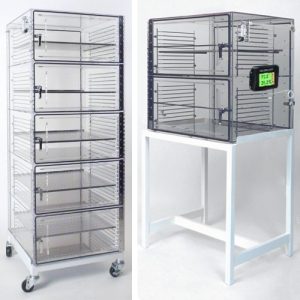Static Dissipative Acrylic Data Sheet – ESD/Cleanroom Properties for Acrylic Material
TDI Static Dissipative Desiccators and Gloveboxes
Static Dissipative Acrylic Data Sheet for Material used on our Desiccators & Gloveboxes
FEATURES AND BENEFITS:
- Cannot be tribocharged when properly grounded.
- Prevents build-up of static charge and accumulation of harmful contamination.
- Electrostatic decay in less than 0.05 second per Federal Test Standard 101C, Method 4046.1*. Results in rapid static dissipation without arcing.
- The surface resistivity of 106 – 108 ohms per square. Provides ESD control in a wide range of applications.
- Permanence in static dissipation performance. Avoids high maintenance cost of periodic application of temporary topical anti-stats.
- Amine free, humidity independent and does not outgas under normal operating conditions.
- Excellent optical properties. C-300 surface provides excellent clarity for optimum use of available light.
- Superior chemical resistance. Reduces risk of solvent and chemical damage to the static dissipative surface.
PRECAUTIONS:
- Acrylic plastic is a combustive thermoplastic. Avoid exposure to flame and excessive heat. Observe fire precautions appropriate for comparable forms of wood and paper.
- Clean with soap and water. Do not use abrasives. Avoid inappropriate contact with solvents.
Static Dissipative Acrylic for ESD and Cleanroom ApplicationsTypical Physical Properties (Typical but not Guaranteed for 0.25-inch Material) |
|||
| PROPERTY | TEST METHOD | UNITS | AC-300 ACRYLIC |
| PHYSICAL | |||
| Specific Gravity | ASTM D-792 | – | 1.19 |
| Pencil Hardness | ASTM D-3363 | Hardness Scale | 5H |
| MECHANICAL | |||
| Tensile Strength | |||
| Ultimate | ASTM D-638 | psi | 10,000 |
| Elongation | ASTM D-638 | % | 4.5 |
| Tensile Modulus | ASTM D-638 | psi | 400,000 |
| Flexural Strength | ASTM D-790 | psi | 16,500 |
| Flexural Modulus | ASTM D-790 | psi | 475,000 |
| Compressive Strength | ASTM D-695 | psi | 18,000 |
| Izod Impact Strength | ASTM D-256 | ft-lb/inch of notch | 0.4 |
| THERMAL | |||
| Deflection Temperature (264 psi Load) | ASTM D-648 | F | 205 |
| Vicat Softening Point | ASTM D1525 | F | 239 |
| Maximum Continuous Service Temperature | – | F | 170 |
| Coefficient of Thermal Expansion | ASTM D-696 | in/in/F | 4.0 x 10 |
| Coefficient of Thermal Conductivity | Cenco-Fitch | BTU/hr-fz F/in | 1.3 |
| FLAMMABILITY | |||
| Horizontal Burn (Flame Spread) | ASTM D-635 | in/min | 1.1 |
| UL Rating | UL Classification | UL94 | 94HB |
| OPTICAL | |||
| 3mm Transparent Clear Transmittance – Total |
ASTM D-1003 | % | 9 |
| Haze | ASTM D-1003 | % | 94HB |
| ELECTRICAL | |||
| Surface Resistivity | ASTM D-257 | ohms/sq. | 106-108 |
| Electrostatic Decay | FTS 101C, Method 4046.1 | sec | Less than 0.05 |
Federal Test Standard 101C, Method 4046.1 as described in EIA-541, Appendix F, Measurement of Electrostatic Decay Properties of Dissipative Planar Materials.
Chemical Resistance ASTM D-543(Samples immersed in the specified chemicals for 24 hours at room temperature and visually examined.) |
||
| CHEMICAL | SURFACE ATTACK | VISUAL EVALUATION |
| De-Ionized Water | None | Clear |
| 30% Sodium Hydroxide | None | Clear |
| 30% Sulfuric Acid | None | Clear |
| 30% Nitric Acid | Slight Pitting | Clear |
| 48% Hydrofluoric Acid | Severe Attack | White, Rubbery |
| Methanol | Slight | Hazy |
| Ethanol | None | Clear |
| Isopropyl Alcohol | None | Clear |
| Acetone | Severe Pitting | Clear |
| Methylene Chloride | Sample Dissolved | Sample Dissolved |
